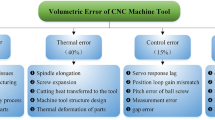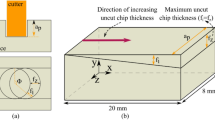Abstract
Workpiece deformation must be controlled in the numerical control machining process. Fixture layout and clamping force are two main aspects that influence the degree and distribution of machining deformation. In this paper, a multi-objective model was established to reduce the degree of deformation and to increase the distributing uniformity of deformation. The finite element method was employed to analyze the deformation. A genetic algorithm was developed to solve the optimization model. Finally, an example illustrated that a satisfactory result was obtained, which is far superior to the experiential one. The multi-objective model can reduce the machining deformation effectively and improve the distribution condition.
Similar content being viewed by others
References
King LS, Hutter I (1993) Theoretical approach for generating optimal fixturing locations for prismatic workparts in automated assembly. J Manuf Syst 12(5):409–416
De Meter EC (1995) Min-Max load model for optimizing machine fixture performance. ASME J Eng Ind 117(2):183–186
De Meter EC (1998) Fast support layout optimization. Int J Mach Tools Manuf 38(10–11):1221–1239
Li B, Melkote SN (1999) Improved workpiece location accuracy through fixture layout optimization. Int J Mach Tools Manuf 39(6):871–883
Li B, Melkote SN (2001) Fixture clamping force optimization and its impact on workpiece location accuracy. Int J Adv Manuf Technol 17(2):104–113
Li B, Melkote SN (2001) Optimal fixture design accounting for the effect of workpiece dynamics. Int J Adv Manuf Technol 18(10):701–707
Lee JD, Haynes LS (1987) Finite element analysis of flexible fixturing system. ASME J Eng Ind 109(2):134–139
Menassa RJ, DeVries WR (1991) Optimization methods applied to selecting support positions in fixture design. ASME J Eng Ind 113:412–418
Cai W, Hu SJ, Yuan JX (1996) Deformable sheet metal fixturing: principles, algorithms and simulations. ASME J Manuf Sci Eng 118(3):318–324
Qin GH, Zhang WH, Zhou XL (2005) Modeling and optimal design of fixture clamping scheme. Mech Sci Technol 24(4):438–442, 446, (in Chinese)
Deng HY, Melkote SN (2006) Determination of minimum clamping forces for dynamically stable fixturing. Int J Mach Tools Manuf 46(7–8):847–857
Wu NH, Chan KC (1996) A genetic algorithm-based approach to optimal fixture configuration. Compute Eng 31(3/4):919–924
Ishikawa Y, Aoyama T(1996) Optimization of fixturing condition by means of the genetic algorithm. Trans J Sci Manuf Eng, Part C 65:2409–2416
Vallapuzha S, De Meter EC, Choudhuri S, et al (2002) An investigation into the use of spatial coordinates for the genetic algorithm-based solution of the fixture layout optimization problem. Int J Mach Tools Manuf 42(2):265–275
Vallapuzha S, De Meter EC, Choudhuri S, et al (2002) An investigation of the effectiveness of fixture layout optimization methods. Int J Mach Tools Manuf 42(2):251–263
Kulankara K, Melkote SN (2000) Machining fixture layout optimization using the genetic algorithm. Int J Mach Tools Manuf 40(4):579–598
Kulankara K, Satyanarayana S, Melkote SN (2002) Iterative fixture layout and clamping force optimization using the genetic algorithm. J Manuf Sci Eng 124(1):119–125
Lai XM, Luo LJ, Lin ZQ (2004) Flexible assembly fixture layout modeling and optimization based on genetic algorithm. Chin J Mech Eng 1:89–92
Hamedi M (2005) Intelligent fixture design through a hybrid system of artificial neural network and genetic algorithm. Artif Intell Rev 23(3):295–311
Kumar AS, Subramaniam V, Seow KC (2001) Conceptual design of fixtures using genetic algorithms. J Intell Manuf 12(2):31–42
Kaya N (2006) Machining fixture locating and clamping position optimization using genetic algorithms. Compute Ind 57(2):112–120
Zhou XL, Zhang WH, Qin GH (2005) On optimizing fixture layout and clamping force simultaneously using genetic algorithm (in Chinese). Mech Sci Technol 24(3):339–342
Kaya N, Öztürk F (2003) The application of chip removal and frictional contact analysis for workpiece-fixture layout verification. Int J Adv Manuf Technol 21(6):411–419
Author information
Authors and Affiliations
Corresponding author
Rights and permissions
About this article
Cite this article
Chen, W., Ni, L. & Xue, J. Deformation control through fixture layout design and clamping force optimization. Int J Adv Manuf Technol 38, 860–867 (2008). https://doi.org/10.1007/s00170-007-1153-2
Received:
Accepted:
Published:
Issue Date:
DOI: https://doi.org/10.1007/s00170-007-1153-2




